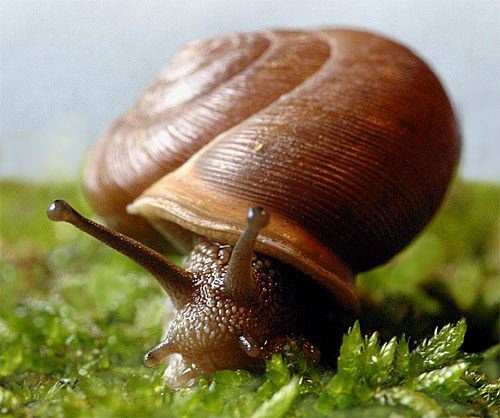Snails'' natural glue can be used to develop better surgical adhesives
 Washington, May 3 : Researchers at Ithaca College, US, have shed new light on the nature of the adhesive mechanism that snails use to attach themselves onto slippery surfaces, which could lead to developing surgical adhesives that would bind to wet surfaces and be less invasive than suturing mechanisms.
Washington, May 3 : Researchers at Ithaca College, US, have shed new light on the nature of the adhesive mechanism that snails use to attach themselves onto slippery surfaces, which could lead to developing surgical adhesives that would bind to wet surfaces and be less invasive than suturing mechanisms.
This research follows up on an earlier study that identified the key characteristics controlling this transition from a water-based gel into a powerful yet flexible adhesive.
"The strength of the natural adhesive comes from the way long, rope-like polymers chemically tie together, or cross link, at certain points," said Andrew Smith, associate professor of biology.
"In our previous studies, we had shown that metals were essential to the formation of cross-links. This is unusual, as some combination of electrostatic and hydrophobic interactions are commonly responsible for the formation of cross-links in other gels," he added.
Electrostatic interactions occur when a negatively charged group on one polymer is attracted to a positively charged group on another.
Hydrophobic interactions take place when regions of a polymer don''t interact with water, so they stick together to avoid contacting water.
"We used several approaches to break these interactions, and the treatments that normally disrupt them had no impact on the glue''s mechanical integrity or ability to set," Smith said.
"Our study conclusively showed that electrostatic and hydrophobic interactions do not play any detectable role. Removing metals alone caused the glue to fall apart. This was exciting and unexpected," he added.
Removing the metals, however, didn''t completely break down the gel.
The researchers discovered that a specific protein was responsible for forming strong cross-links that were unaffected when the metals were removed after the glue set.
But, when metals were removed before the glue set, the cross-links didn''t form.
"This is a very unusual material we''re looking at," Smith said. "By discovering that metals are central to forming cross-links, we know there are several intriguing mechanisms that could hold the glue together," he added.
For example, zinc, calcium and iron ions can bind very strongly to several molecules at the same time, thereby effectively joining them together. Iron and copper can also catalyze reactions that trigger strong cross-link formation.
"The significance of this is that we are much farther along the path to our goal of identifying how the glue works so that synthetic mimics can be made," Smith said. (ANI)